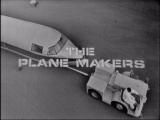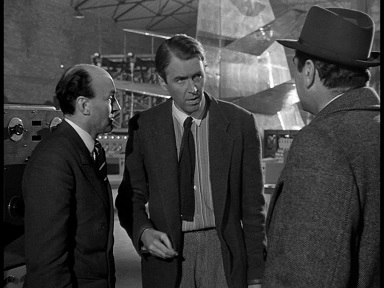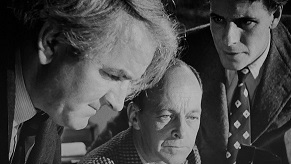
“Aviation movies….”
Before the Plane Makers
The Plane Makers dealt with the commercial and political pressures of the British aviation industry of the 1960’s. In the period before the TV show, air flight had been an exotic, elitist subject, slightly on the edge of science fiction.
The 1936 film of “H.G. Wells’ Things To Come” had predicted a protracted war, beginning in 1940 and lasting 30 years. The devastated country regresses to a feudalistic wasteland ruled by forceful Luddites like Ralph Richardson’s “Boss”. Eventually the tyrant’s forces are overcome by Raymond Massey’s league of technocrats – Wings Over The World – which uses futuristic planes to liberate the people.
Massey’s pale and atrophied aviator seems to foreshadow Alan Dobie’s character David Corbett, the aircraft designer who would challenge John Wilder in the third series of “The Plane Makers”. Things To Come also accurately foretold the “New Elizabethan” post-war mentality in which jet aviation would been seen to herald a bright new future. But in England there are always clouds on the horizon.
In 1948, former aeronautical engineer Nevil Shute published “No Highway”. Shute’s novel is extremely readable. It takes dry and potentially confusing subjects like administration and metal fatigue and lays them out in a clear and pacey fashion. However, the novel is to some extent science fiction because it predicts disasters which would take place some year’s later.

Mick Wiggins’ evocative 2009 cover for Vintage Classics’ edition of “No Highway”.
The novel is narrated by Dr Dennis Scott, the new head of the structural department at Farnborough Royal Aircraft Establishment. He comes across Theodore Honey, who is researching metal fatigue in the tail plane of a new Reindeer aircraft. Honey regards it as a theory to be tested but Scott realises that a Reindeer crashed in Canada with flying hours close to Honey’s estimate. “It was not a happy thought that there were Reindeers flying in the air at that moment, putting up the hours towards the point where Mr Honey said their tails would break.”
Scott sends Honey to Canada examine the wreck for signs of metal fatigue. Shute presents a picture of a lost era of flight for the privileged few – Honey is ferried by coach from the terminal at Victoria, “where a rug was wrapped around to protect him from the evening chill.” When he boards the aircraft, a stewardess seats him and shows him how to fasten his safety belt. Honey is impressed by the luxury of the plane and learns that it is a Reindeer. “He was not in the least perturbed because he had complete confidence in the check I was keeping on the fling time that all the Reindeers had done.”
However, during a tour of the flight cabin, Honey learns that his plane had been on loan to another airline before beginning the trans-Atlantic run, and its flying hours are close to the point where his calculations predict the tailplane will break. What had been an abstract problem becomes a personal crisis.
By this point, Shute has deftly tightened his narrative focus; from viewing Mr Honey and his eccentricities from the outside, we suddenly learn the inner thoughts and history – not just of Honey but also of the Captain – who was a friend of the pilot whose Reindeer crashed, and believes the accident report blaming pilot error was wrong.
Set at some time around Summer 1947 and published in 1948, “No Highway” predates the 1949 launch of the world’s first commercial jetliner, the de Havilland Comet. It definitely predates the crashes in 1953 and 1954 which were eventually traced at Farnborough to metal fatigue in the square window frames. Where Shute had predicted a loss of control due to the tail plane falling off, the Comets had been destroyed by explosive decompression of the structure. In both early Comet crashes, “pilot error” was blamed, and the four-year grounding of the Comet is blamed for its commercial failure (in Shute’s novel, although commercial pressures are crucial, the redesign is implemented without any real loss of flying time).
In 1951, “No Highway” was filmed in England by 20th Century Fox. The film starred James Stewart and was directed by Henry Koster, who had also directed Stewart in “Harvey”. Contrary to expectations, Stewart does not downplay Honey’s eccentricity – if anything he makes Honey more absent-minded than the character in the novel – but towards the end he gets Frank Capra moment, resigning from Farnborough and threatening to sabotage every Reindeer plane in service.

Maurice Denham introduces James Stewart to Jack Hawkins as the Reindeer tail is tested in the background.
The script is relatively faithful to the novel, although much detail has to be left out. The Honey of the book is a Fortean and he and his precocious daughter Elspeth use spiritualism to solve part of the mystery. None of this makes it into the movie, although 12 year old Janette Scott is very convincing as Elspeth. The film admirably distils the essence of the novel – As Dr Scott, stolid Jack Hawkins arrives at Farnborough Royal Aircraft Establishment (a de Havilland Vampire soaring over the ornate gates as his car approaches), meets the director and spots a model of the film’s Reindeer (“not hard to recognise by that tail”) made from the same revolutionary alloy as the plane. Scott’s montage tour of the labs ends in the shed where Honey is testing a full-size version of the Reindeer tail. Within three minutes the story has been set-up. After learning more about Honey, Scott comes across an old friend and test pilot, the swashbuckling Penworthy (David Hutcheson). It is he who voices the private disbelief in the “pilot error” verdict, rather than the Captain of the second Reindeer (Niall MacGinnis). Confirmation by the cheery “Battle of Britain” character of Penworthy tends to reinforce Scott’s belief in Honey’s theory, despite the exaggerated eccentricity of Stewart’s portrayal.
The film diverges most from the book towards the end, although mainly to focus on Stewart as the star. Honey’s last-minute appreciation of the role of temperature in the movie is actually given to Scott by Canadian accident inspectors in the book while he is searching for the wreckage of the first Reindeer. Similarly, the Honey of the book is not part of the meeting at the Ministry of Supply where the Honey of the film makes his threat to ground every Reindeer.
Of most interest to viewers of “The Plane Makers” is the picture “No Highway” gives of the British aviation industry in the immediate post-war era. This is before the consolidation imposed in 1957 by Duncan Sandys and depicts construction firms run by autocratic designers who regard themselves as gentlemen rather than players. When Arthur Sugden concedes in “The Homecoming” that John Wilder is “a brilliant man” and that, “the industry’s needed someone like him for a very long time, ” it’s characters like E.P. Prendergast who he’s alluding to. It’s with some irony that one of the facts Prendergast digs up to discredit Honey is that in 1936 he was a member of the Interplanetary Society and designed a rocket-propelled spaceship for a journey to the moon.

Wilder(Patrick Wymark) and Sugden(Reginald Marsh) in “The Plane Makers”
In America, the film was retitled “No Highway in the Sky” to ensure cinemagoers didn’t mistake it for a movie about truckers. In fact, the title comes from John Masefield’s, “The Wanderer” which reads, “No highway more, no track, all being blind, The way to go shall glimmer in the mind,” and continues, “adventure on, for from the littlest clue, has come whatever worth man ever knew.”
This sentiment drives David Lean’s 1952 movie, The Sound Barrier. Set firmly within the private sector, the film concerns autocratic aircraft manufacturer John Ridgefield (Ralph Richardson) and his quest to perfect faster-than-sound travel.
The film is a blend of science fiction and propaganda - it ends with a fanciful solution to the problem of faster-than-sound travel and also convinced two generations that Britain broke the sound barrier when it was actually broken by American Chuck Yeager, five years before the movie.
Terence Rattigan’s script is informed by and makes direct reference to the death of Geoffrey De Havilland Jr in the experimental Swallow, while diving to Mach o.87. Yet it also acknowledges the relatively poor pay of test pilots, when John Justin calculates that take a pay cut of £200 a year (about £6000 today) if he leaves his job as an oil company executive to join Ridgefield as a test pilot.
The film opens with Justin skylarking in his Spitfire during World War Two. As he goes into a dive and approaches the speed of sound, buffeting from the air piling up in front of the plane threatens to wrest control away from him. Richardson, as Ridgeway, later explains the “compressibility” effect to his daughter (Ann Todd) by swishing a ruler in the air – the sound it makes being caused by the air piling up in front of the ruler.

Designer Joseph Tomelty, Flight Controller Douglas Muir and Test Pilot John Justin listen to Nigel Patrick as he prepares to test The Sound Barrier.
Some familiar faces appear in “The Sound Barrier” - Ralph Michael, who played the industrialist Gillingham in “The Power Game” appears as Denholm Elliott’s flying instructor. Douglas Muir (Tom Bancroft in “The Plane Makers”) is the Flight Controller during the fateful tests. John Justin, would marry Barbara Murray (Pamela Wilder) in 1952, although their marriage had ended by the time “The Plane Makers” began.
Terence Rattigan’s original script, dramatising research by Lean, had been about the conflict between Ridgeway and his three sons. It was studio head Alexander Korda who suggested turning two of the sons into a daughter and son-in-law. Pilot Tony Garthwaite (Nigel Patrick) marries Todd, and during his first dinner at the family home hears the test firing of jet engines at the aircraft plant. It’s “the most exciting sound I’ve ever heard”, and Patrick is quickly tempted to the job of chief test pilot.
Where Malcolm Arnold’s score for “No Highway” had been purely functional, his score for “The Sound Barrier” is inspirational. Midway through the film Patrick is observing another galaxy through Richardson’s telescope and musing that it’s actually a view of the past, when Richardson tells him that the telescope shows the past, present and future all in one. Arnold introduces a whimsical woodwind theme (almost like something out of an Ealing comedy). The theme is repeated as Patrick gazes out of his bedroom window on the eve of his test flight, surrounded by a halo of stars and accompanies the very last shot of the film. It’s as if to underscore Richardson’s insistence that we should “adventure on.”

Todd challenges her father, saying that if they can conquer the Sound Barrier, all it means is that the minority who can afford to fly to New York can get there a couple of hours earlier. But Richardson insists that its part of the continual quest to surmount all obstacles. In Masefield’s words, “The next to lighten all men may be you.”
While the human cost in “The Sound Barrier” is considerable there is never any weighing of financial cost. Ralph Richardson plays his character with a Yorkshire accent to signify a self-made man. He seems to run the company alone. In reality, while there would have been other directors, they would not have concerned themselves with how much money the firm was making. As James Hamilton-Paterson points out in “Empire of the Clouds” , the directors of these family-run businesses thought themselves above balance sheets and indulged in two hour lunches which “softened the indignity of having to think of themselves as industrialists or even – God Forbid –‘in trade’.”
Seven months after the release of The Sound Barrier, Two Cities Films released Anthony Asquith and William Fairchild's adaptation of John Pudney's 1952 novel The Net . Retitled Project M7 for US release, the movie deals with the pressures of life in a secret research station. James Donald (Quatermass And The Pit ) stars as Professor Heathley, who leads a project at the Port Amberley research establishment to develop an atomic powered, faster-than-sound jet. Heathley sees this as just an intermediate stage before space travel. Heathley wants to pilot the test flight himself, but the project Director (Maurice Denham - who had played a similar role in No Highway) insists that the jet should fly under the ground control of Alex Leon (Herbert Lom). When the Director dies under suspicious circumstances, security chief Sam Seagram (Robert Beatty) must decide if it's an accident or enemy action.
The Net foreshadows elements in the third series of The Plane Makers. It is more a story about research and security that happens to feature a jet plane, rather than being about the aviation industry (Pudney makes it fairly clear that his novel is inspired by 1950's security breaches at the UK Atomic Energy Research Establishment). Nevertheless, the movie features some impressive special effects of the atomic jet plane from Bill Warrington, Bryan Langley and Albert Whitlock. You can read a detailed review, comparing the book with the film here here - The Net although this does give away the ending of the film.
Released in 1960, Cone of Silence was based on a novel by former pilot and air safety expert David Beaty. Bernard Lee plays an experienced pilot who the industry wants to make a scapegoat following the crash of a new jet plane, ominously called The Phoenix. Noel Willman (from The Net reappears, this time as the possessive aircraft designer who still carries his original back-of-an-envelope sketch of The Pheonix in his jacket pocket. Directed by Charles Frend, Cone of Silence opens and closes with two Board of Trade inquiries in which George Sanders tries to demolish Lee's reputation and preserve the integrity of The Phoenix. The film focuses much more on the internal politics of the airline, depicting the personal emotions which colour the supposedly objective decisions of administrators Peter Cushing and Michael Craig. Glen Erickson reviews the film here with some interesting observations on real-life aerospace testing.
Above all, films like “No Highway” and “The Sound Barrier” give a picture of the British aircraft industry before the time of “The Plane Makers”. A world that had already been left behind.
You can see “The Homecoming” on the new complete Plane Makers DVD Box Set from Network